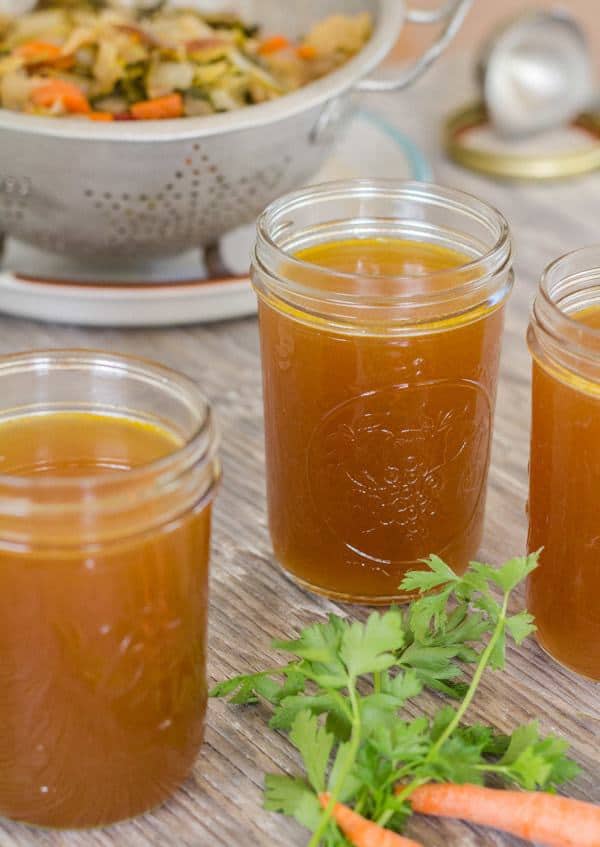In a world where food waste often fills landfills before it fills bellies, making vegetable broth from scraps is a revolutionary act of sustainability, flavor, and thrift. With a few humble leftovers and a bit of simmering time, you can transform peelings and trimmings into a rich, soul-warming broth.
1. How to Make Vegetable Broth
( Yield: 8–9 cups of broth )
Ingredients
- 5 cups vegetable scraps (onion skins, carrot peels, celery ends, mushroom stems, garlic skins, leek greens, herb stalks)
- 10 cups water
- 1 bay leaf
- 6–8 whole black peppercorns
- 1 tsp kosher salt
- Optional: 1 small piece of kombu (dried seaweed) or 1 tbsp soy sauce for umami
Equipment
- Large stockpot (8–10 quarts)
- Fine mesh sieve or cheesecloth
- Large bowl or heat-safe containers for straining
- Wooden spoon
Instructions
Prepare Scraps: Collect scraps over a few days, storing them in a sealed bag or container in the refrigerator or freezer. Rinse thoroughly under cold water to remove dirt or grit.
Combine Ingredients: Place scraps in a large stockpot. Add 10 cups of cold water ( Use a 1:2 ratio of scraps to water as a general guide ), bay leaf, peppercorns, salt, and optional kombu or soy sauce.
Bring to a Boil: Set the pot over medium-high heat and bring to a gentle boil, about 10–15 minutes. Skim any foam that rises to the surface with a spoon.
Simmer: Reduce heat to low, maintaining a gentle simmer. Cook uncovered for 60–75 minutes, stirring occasionally to ensure even flavor extraction.
Taste and Adjust: After 60 minutes, taste the broth. If it lacks depth, simmer for another 15 minutes. Avoid over-salting; you can adjust seasoning later when using the broth.
Strain: Remove from heat and let cool slightly. Strain through a fine mesh sieve or cheesecloth into a large bowl or clean containers. Press solids gently with a spoon to extract all liquid. Discard solids.
Cool: Allow broth to cool to room temperature, about 1 hour, before storing to prevent condensation in containers.

2. Tips for Perfect Homemade Vegetable Broth
To craft a standout broth, focus on balance and technique. Combine sweet scraps (carrots, onions), earthy ones (mushrooms, celery), and aromatics (garlic, herbs) for a well-rounded flavor. Fresh or recently frozen scraps produce a cleaner taste, so avoid using wilted or moldy pieces.
Keep the simmer low and steady to extract flavors without clouding the broth or turning it bitter. For a richer profile, roast scraps on a baking sheet at 425°F for 20–25 minutes until caramelized before adding to the pot. A small parmesan rind, added during simmering, boosts umami, but remove it before straining.
Taste periodically and avoid heavy seasoning during cooking. If the broth feels flat, add a splash of white wine or a teaspoon of tomato paste for brightness. For clarity, strain twice through cheesecloth. If you want a concentrated broth, simmer strained liquid for an additional 20 minutes to reduce it.
Avoid starchy vegetables like potatoes or strong-flavored ones like cabbage, broccoli, or cauliflower, as they can muddy the flavor or make the broth bitter. If you have leek greens or parsnip peels, toss them in for extra depth.
3. What to Do With Vegetable Broth
Vegetable broth is incredibly versatile. Use it as a foundation for hearty soups like vegetable barley, miso, or tortellini.
It shines in grain dishes—cook rice, couscous, or bulgur in broth instead of water for added flavor. Make creamy risottos or savory polenta by stirring in broth gradually.
It’s also a star in sauces and gravies. Deglaze a pan with broth for a quick pan sauce or simmer it with herbs and flour for a vegetarian gravy. Blend it into pureed soups, like butternut squash or leek, for depth without cream.
For a light meal, season broth with lemon and herbs and sip it warm. You can even use it to braise greens or poach dumplings, infusing subtle flavor.
4. How to Store & Reheat Vegetable Broth
Proper storage keeps your broth fresh and flavorful. Pour cooled broth into airtight glass jars or BPA-free plastic containers, leaving 1 inch of headspace to account for freezing expansion. Refrigerate for up to 5–7 days. For longer storage, freeze in 1- or 2-cup portions or ice cube trays for easy use; frozen broth lasts up to 6 months.

To reheat, thaw frozen broth in the refrigerator for 12–24 hours. Heat on the stovetop over medium heat, stirring occasionally, until steaming (about 5–7 minutes for 2 cups).
For small amounts, microwave in a heat-safe container in 30-second bursts, stirring between, until hot. Reheat only what you need to preserve quality and avoid bacterial growth.
Making vegetable broth from scraps isn’t just a cooking technique—it’s a quiet rebellion against waste, a celebration of resourcefulness, and a flavorful nod to the unsung heroes of the cutting board. 😀 😀 😀
So next time you’re about to toss that onion skin or carrot top, pause. Toss it in the freezer instead. The broth you brew today could be the soul of tomorrow’s meal—and a standing ovation for your inner kitchen alchemist. 🌿🍵
Raed More: Miso Soup Recipe for Beginners
